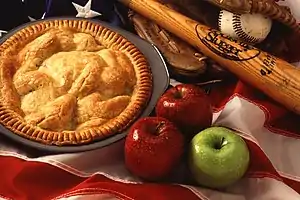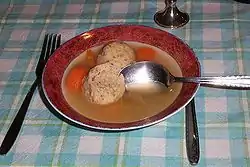| Part of a series on |
| American cuisine |
|---|
 |
The cuisine of New York City comprises many cuisines belonging to various ethnic groups that have entered the United States through the city. Almost all ethnic cuisines are well represented in New York, both within and outside the various ethnic neighborhoods.[1]
The city's New York Restaurant Week started in 1992 and has spread around the world due to the discounted prices that such a deal offers.[2] In New York there are over 12,000 bodegas, delis, and groceries, and many among them are open 24 hours a day, 7 days a week.
Food identified with New York
Food associated with or popularized in New York

- Manhattan clam chowder
- New York-style cheesecake
- New York-style pizza
- New York-style bagel
- New York-style pastrami
- Corned beef[4]
- Baked pretzels
- New York-style Italian ice
- Knish
- Eggs Benedict
- Chopped cheese
- Lobster Newberg
- Waldorf salad
- Doughnuts
- Delmonico steak
- Black and white cookie
- Bacon, egg and cheese sandwich on a roll
Ashkenazi Jewish cuisine

Much of the cuisine usually associated with New York stems in part from its large community of Ashkenazi Jews and their descendants.
The world-famous New York institution of the delicatessen, commonly referred to as a "deli," was originally an institution of the city's Jewry. Much of New York's Jewish fare, predominantly based on Ashkenazi Jewish cuisine, has become popular around the globe, especially bagels. (New York City's Jewish community is also famously fond of Chinese food, and many members of this community think of it as their second ethnic cuisine.[5])
- Bagel and cream cheese
- Bialy[4]
- Blintzes[4]
- Brisket[4]
- Celery soda
- Challah bread
- Chopped chicken liver
- Corned beef[4]
- Cream cheese
- Egg cream
- Gefilte fish
- Kishka
- Knish[4]
- Lokshen soup
- Matzo
- Matzo ball soup
- New York-style bagels and lox (see also: appetizing)[4]
- New York-style pastrami, pastrami on rye
- Potato kugel
- Potato pancake
- Pickled cucumbers (especially dill pickles)
- Tongue
- Whitefish with and without pike
Italian-American cuisine
A large part of the cuisine associated with New York stems from its large community of Italian-Americans and their descendants. Much of New York's Italian fare has become popular around the globe, especially New York-style pizza.
- Arancini
- Cannoli
- Cappuccino
- Chicken parmigiana
- Espresso
- Fried calamari
- Italian bread
- Italian ice/Granita
- New York-style Italian ice
- New York-style pizza
- Pani câ meusa
- Pasta primavera
- Penne alla vodka
- Rainbow cookies
- Sausage and peppers
- Sfogliatella
- Sicilian bread
- Sicilian style pizza
- Spaghetti and meatballs
Chino-Latino cuisine
Chino-Latino[6] cuisine in New York is primarily associated with the immigration of Chinese Cubans following the Cuban Revolution.[7] Chino-Latino dishes include:
- Chicken and broccoli
- Cuban chicharrones de pollo[8]
- Egg drop soup
- Fried pork chop
- Fried rice
- Lumpiang Shanghai
- Oxtail stew
- Sesame chicken
- White rice with black beans and churrasco
Dishes invented or claimed to have been invented in New York
- Beef Negimaki
- Chef salad
- Chicken à la King[9]
- Chicken and waffles
- Chicken divan
- Cronut
- Delmonico steak
- Egg cream
- Eggs Benedict
- General Tso's chicken
- Ice cream cone
- Lobster Newburg
- Mallomars[10]
- Manhattan
- Manhattan special—a type of carbonated espresso drink.
- Pasta primavera
- Penne alla vodka
- Reuben sandwich
- Sausage and peppers
- Steak Diane
- Spaghetti and meatballs
- Vichyssoise
- Waldorf salad
Street food


- Arepas
- Calzones
- Chinese kebabs (chuanr)
- Churros
- Corndogs
- Cuchifritos
- Hot cup of Jo October
- Dumplings
- Falafel
- Fried chicken
- Fried noodles
- Gray's Papaya, Papaya King—combined papaya juice/hot dog stands
- Grilled chestnuts[3]
- Gyros/Shawarma
- Halal cart chicken/lamb over rice[11]
- Hamburgers
- Honey-roasted peanuts, almonds, cashews, and coconut
- Hot dog stands
- Italian ice
- Italian sausage, bratwurst
- Knishes
- Mister Softee ice cream
- Muffins
- Nutcrackers, illicit alcoholic drinks
- Piragua
- Pizza, especially New York-style pizza
- Soft pretzels[3]
- Souvlaki/Shish kebab
- Stromboli
- Tacos
- Take-out soup, as Soup Kitchen International
Enclaves reflecting national cuisines
The Bronx
- Bedford Park – Mexican, Puerto Rican, Dominican, Korean (on 204th St.)
- Belmont – Italian, Albanian (also known as "Arthur Avenue," "Little Italy")
- City Island – Italian, seafood
- Morris Park – Italian, Albanian
- Norwood – Filipino (formerly Irish, less so today)
- Riverdale – Jewish, Irish
- South Bronx – Puerto Rican, Dominican
- Wakefield – Jamaican, West Indian
- Woodlawn – Irish
Queens

- Astoria – Greek, Italian, Eastern-European, Brazilian, Egyptian and other Arabic
- Bellerose – Indian and Pakistani
- Elmhurst – Chinese, Indonesian, Thai, Malaysian, Vietnamese
- Flushing – Chinese and Korean
- Forest Hills, Kew Gardens Hills, Rego Park – Jewish, Russian and Uzbek
- Howard Beach, Ozone Park – Italian
- Glendale – German and Polish
- Jackson Heights – Indian, Pakistani, Bangladeshi, Colombian, Ecuadorian, Peruvian, Korean, Filipino, Thai, Tibetan, Bhutanese, Mexican
- Jamaica – Bangladeshi, Caribbean, African-American, African, Creole
- Little Neck – Arab, Chinese, Italian
- Richmond Hill; South Ozone Park – Indian, Guyanese, Trinidadian, Pakistani, Bangladeshi
- The Rockaways – Irish, Jewish
- Woodhaven – Irish, Dominican, Mexican, Guyanese
- Woodside; Sunnyside – Filipino, Irish, Mexican, Tibetan, Romanian
Brooklyn
- Bay Ridge – Irish, Italian, Greek, Turkish, Lebanese, Palestinian, Yemeni and other Arabic
- Bedford-Stuyvesant – African-American, Jamaican, Trinidadian, Puerto Rican and West Indian
- Bensonhurst – Italian, Chinese, Turkish, Russian, Mexican, Uzbek
- Borough Park – Jewish, Italian, Mexican, Chinese
- Brighton Beach – Russian, Georgian, Turkish, Pakistani and Ukrainian
- Bushwick – Puerto Rican, Mexican, Dominican, and Ecuadorian
- Canarsie – Jamaican, West Indian, African-American
- Carroll Gardens – Italian
- Crown Heights – Jamaican, West Indian, and Jewish
- East New York – African-American, Dominican, and Puerto Rican
- Flatbush – Jamaican, Haitian, and Creole
- Greenpoint – Polish and Ukrainian
- Kensington – Bengali, Pakistani, Mexican, Uzbek, and Polish
- Midwood – Jewish, Italian, Russian, and Pakistani
- Park Slope – Italian, Irish, French, and Puerto Rican (formerly)
- Red Hook – Puerto Rican, African-American, and Italian
- Sheepshead Bay – Seafood, Chinese, Russian, and Italian
- Sunset Park – Puerto Rican, Chinese, Arab, Mexican and Italian
- Williamsburg – Italian, Jewish, Dominican and Puerto Rican
Staten Island
- Port Richmond – Mexican, Indian, Italian
- Rossville; South Beach; Great Kills – Italian, Russian, Arab and Polish
- Tompkinsville – Italian, Sri Lankan, Pakistani, Indian
Manhattan
- Chinatown – Chinese and Vietnamese
- East Harlem – Puerto Rican, Mexican, Dominican, Chinese-Cuban and Italian
- East Village – Japanese, Korean, Indian and Ukrainian
- Greenwich Village – Italian and Middle Eastern
- Harlem – Italian, African-American, Latin American, West Indian, and West African
- Koreatown – Korean
- Nolita – Australian
- Little Italy – Italian
- Lower East Side – Puerto Rican, Jewish, Italian, and Latin American
- Murray Hill – Indian, Pakistani and Bangladeshi
- Upper West Side, Manhattan – Jewish, Chinese-Latino
- Washington Heights – Dominican, Puerto Rican, Mexican and Jewish
- Upper East Side – German, Czech, Hungarian
Notable food and beverage companies

- A&P
- AriZona Beverage Company
- Balducci's
- Bamonte's
- Benihana
- Blimpie
- C-Town Supermarkets
- Caffe Reggio – first espresso bar to introduce cappuccino in America
- Carnegie Deli
- Carvel (restaurant)
- Clinton St. Baking Company & Restaurant
- Dean & DeLuca
- Dr. Brown's – sodas
- Drake's Cakes – cakes, pies, pastries
- Domino Foods
- Entenmann's – cakes, pies, pastries
- Fairway Market
- Ferrara Bakery and Cafe – first Italian cafe in America
- Food Network – cable-TV channel
- Fox's U-bet
- Fraunces Tavern – George Washington said goodbye to his troops here. Some departments of his new federal government were originally located here.
- Golden Krust Caribbean Bakery & Grill
- Gray's Papaya – hot dog institution where there is always a "recession special"
- Grotta Azzurra
- Grimaldi's Pizzeria
- Häagen-Dazs
- Hebrew National
- Junior's – "The World's Most Fabulous Cheesecake"
- Katz's Deli
- Kesté
- Key Food – supermarket
- L&B Spumoni Gardens
- Lindy's
- Lombardi's – first pizzeria in America
- Nathan's
- Now and Later – candy
- Papaya King
- PepsiCo, Inc.
- Peter Luger Steak House
- Ray's Pizza – a fierce debate over which was the original
- Russian Tea Room
- Second Avenue Deli
- Serendipity 3
- Sbarro
- Shake Shack
- Snapple
- Stella D'oro – biscuits, cookies
- T.G.I. Friday's – originally a NYC bar
- Totonno's – first pizzeria in Brooklyn
- The Halal Guys
- Vitamin Water
- Western Beef-supermarket
- Yoo-hoo – chocolate drink
- Zabar's
See also
References
- ↑ Zelinsky, W. (1985). "The roving palate: North America's ethnic restaurant cuisines". Geoforum. 16: 51–72. doi:10.1016/0016-7185(85)90006-5.
- ↑ Gergely Baics, Feeding Gotham: The Political Economy and Geography of Food in New York, 1790–1860 (Princeton UP, 2016)
- 1 2 3 Let's Go New York City. Let's Go. 2008-11-25. ISBN 9780312385804. Retrieved May 14, 2011.
- 1 2 3 4 5 6 7 Gilbert, Jonathan (2010). Michelin Green Guide New York City. Portugal: Michelin España. ISBN 9781906261863.
- ↑ Tuchman, Gary; Harry Gene Levine (October 1993). "New York Jews and Chinese Food: The social construction of an ethnic pattern". Journal of Contemporary Ethnography. 22 (3): 1. doi:10.1177/089124193022003005. S2CID 143368179. Retrieved 9 May 2013.
- ↑ Chiu, Lisa. "Cuban-Chinese Cuisine Is a Specific Take on Chino-Latino Food Fusion". ThoughtCo. Retrieved 2019-05-10.
- ↑ Siu, Lok (Spring 2008). "Chino Latino Restaurants: Converging Communities, Identities, and Cultures". Afro-Hispanic Review. 27 (1): 161–171. JSTOR 23055229.
- ↑ Gonzalez, Clara (2004-12-28). "Chicharrón de Pollo: Recipe + Video for the Crispiest Chicken Bites". Dominican Cooking. Retrieved 2021-03-22.
- ↑ Editorial (5 March 1915). Chicken a la King Inventor Dies. New York Tribune, pg. 9, col. 5
- ↑ Barron, James (December 8, 2005). "The Cookie That Comes Out in the Cold". New York Times.
- ↑ Knafo, Saki. "Decline of the Dog". New York Times. Retrieved 9 May 2013.
- ↑ "Serendipity 3". Archived from the original on March 19, 2009. Retrieved March 10, 2009.
Further reading
- Baics, Gergely. Feeding Gotham: The Political Economy and Geography of Food in New York, 1790–1860 (Princeton UP, 2016) xviii, 347 pp.
- Batterberry, Ariane Ruskin & Michael Batterberry (1973). On the Town in New York, from 1776 to the Present. Scribner. ISBN 0-6841-3375-X.
- Hauck-Lawson, Annie; Deutsch, Jonathan, eds. (2010). Gastropolis: Food & New York City. New York: Columbia University Press. ISBN 978-0-231-13652-5.
- Sietsema, Robert. "10 Iconic Foods of New York City, and Where To Find Them Archived 2015-06-09 at the Wayback Machine." Village Voice. Friday February 17, 2012.
External links
 Media related to Cuisine of New York City at Wikimedia Commons
Media related to Cuisine of New York City at Wikimedia Commons- New York Food Anywhere Archived 2011-11-07 at the Wayback Machine
- Who Cooked That Up?
- New York Gastronomic & Cultural Food Tours
- Explore Manhattan's Unique Neighborhoods and Foods Archived 2015-02-06 at the Wayback Machine
- The Best Of Brooklyn Multicultural Ethnic Neighborhood Food Tasting and Culture Tour
- Find NYC street food vendors
- Great Eating In Flushing




